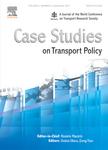版权所有:内蒙古大学图书馆 技术提供:维普资讯• 智图
内蒙古自治区呼和浩特市赛罕区大学西街235号 邮编: 010021

作者机构:Univ Calif Berkeley Dept City & Reg Planning Berkeley CA 94720 USA Vienna Univ Technol Res Ctr Transport Planning & Traff Engn Inst Transportat Vienna Austria
出 版 物:《CASE STUDIES ON TRANSPORT POLICY》 (Case Stud. Transp. Policy)
年 卷 期:2020年第8卷第2期
页 面:658-671页
核心收录:
学科分类:12[管理学] 0202[经济学-应用经济学] 02[经济学] 1201[管理学-管理科学与工程(可授管理学、工学学位)] 020205[经济学-产业经济学] 08[工学] 082303[工学-交通运输规划与管理] 0823[工学-交通运输工程]
基 金:Austrian Marshall Plan Foundation (Marshallplan Jubilaumsstiftung) UC Berkeley Institute of European Studies
主 题:Dockless scooters E-scooters Urban transport Geofences Spatial coverage
摘 要:Background and objective: Electric scooters in shared schemes bring benefits to users in the form of on-demand, point-to-point transport, but pose new challenges for municipal regulation, including access issues related to their geographic availability. The size and position of the geographic service areas, or geofences of scooter-sharing schemes determine where users can locate vehicles to begin a ride and park them to conclude one. The purpose of this study is to understand the spatial variance in scooter geofences in Vienna, Austria and how those differences relate to existing municipal regulations, as well as what may be learned from this case for the benefit of cities worldwide which are also grappling with this mobility trend. Methods: Over the course of one summer, all scooter geofences and no-parking zones for the six operators in Vienna were tracked via smartphone applications and manually digitized on a weekly basis. This enables spatial analyses across scooter operators, and sheds light on such issues as differences in geofence size, shape, and placement, no-parking zone categories, and the frequency of geofence modification. Results: Across the six scooter operators in Vienna, geofence coverage differed sharply over this time period, as did where scooter parking was prohibited (via no-parking zones). Categorization of no-parking zones indicate that the bulk are located around parks, pedestrianized corridors, and cultural institutions. Moreover, all six scooter operators modified their geofences during the course of this study (adding neighborhoods and removing others), which took place without any type of municipal approval or standardized disclosure to users. Four operators expanded their geofences, while two contracted them. Conclusion: These observations combine to establish a scooter-sharing profile of Vienna (matching regulations against spatial outcomes) that can serve as the basis for future comparison cases worldwide. Moreover, they indicate th